Emphysema of the Panlobular Type: Overview, Associations with COPD, and Further Insights
Centrilobular emphysema (CE) and panlobular emphysema (PLE) are two distinct types of emphysema, a chronic lung condition characterised by damage to the alveoli, leading to enlarged air spaces that are less efficient at exchanging gases.
CE, also known as centriacinar emphysema, is the most common type and is strongly associated with smoking. It affects the upper lobes of the lungs, specifically targeting the central portion of the acinus, i.e., the respiratory bronchioles, sparing distal alveoli. On the other hand, PLE, also known as panacinar emphysema, is a rarer form typically linked to alpha-1 antitrypsin deficiency (AATD), a genetic disorder that impairs lung tissue protection. This type of emphysema predominantly affects the lower lobes of the lungs.
The pathological and radiological features of CE and PLE differ significantly. In CE, damage is patchy and localized around the center of the lobule, leading to focal lucencies in upper lobes visible on imaging. In contrast, PLE involves uniform destruction of the entire acinus, causing more homogeneous involvement of the lung lobes.
Both types result in progressive airflow limitation and symptoms typical of emphysema, such as shortness of breath and diminished exercise tolerance. However, PLE may be more severe due to the extensive involvement and is often linked with complications of alpha-1 antitrypsin deficiency.
Mental health interventions can help manage depression and anxiety in people with PLE. Lung volume reduction surgery, which involves removing a diseased portion of lung tissue to reduce pressure in the lung, is another treatment option. The outlook for people with PLE depends on various factors, including overall health, response to medication, and occurrence of complications.
It's important to note that CE is most commonly associated with smoking, while PLE can have various causes, including aging and AAT deficiency. Other potential causes of PLE include Ritalin lung, obliterative bronchiolitis, Swyer-James syndrome, and exposure to toxic gases.
Emphysema and chronic bronchitis fall under the umbrella of COPD (Chronic Obstructive Pulmonary Disease). While chronic bronchitis involves inflammation of the airways, emphysema involves the destruction of the alveoli within the lungs.
There is currently no cure for PLE, but treatments can help slow the progression of the condition and improve quality of life. Treatment options include bronchodilators, anti-inflammatory drugs, supplemental oxygen, lung volume reduction surgery, and mental health interventions. Opioid medications may be used for pain management in people with PLE.
In conclusion, understanding the differences between CE and PLE is crucial for effective diagnosis and treatment. While CE is primarily smoking-related and affects the central parts of upper lobe acini, PLE is rarer, genetically related to AAT deficiency, and predominantly involves lower lobes. Both types require careful management to mitigate symptoms and improve the quality of life for affected individuals.
- Centrilobular emphysema (CE), a smoking-related respiratory condition, is the most common type of emphysema, affecting the upper lobes of the lungs, particularly the central portion of the acinus.
- Panlobular emphysema (PLE), a rarer form of emphysema, is often linked to alpha-1 antitrypsin deficiency, a genetic disorder, and predominantly affects the lower lobes of the lungs.
- Both CE and PLE are chronic pulmonary diseases, characterized by damage to the alveoli, leading to enlarged air spaces and progressive airflow limitation, causing symptoms such as shortness of breath and diminished exercise tolerance.
- Treatment for PLE includes bronchodilators, anti-inflammatory drugs, supplemental oxygen, lung volume reduction surgery, mental health interventions, and opioid medications for pain management.
- Understanding the differences between CE and PLE is crucial for effective diagnosis and treatment, as they fall under the umbrella of COPD (Chronic Obstructive Pulmonary Disease), and have varying causes and pathological characteristics.




